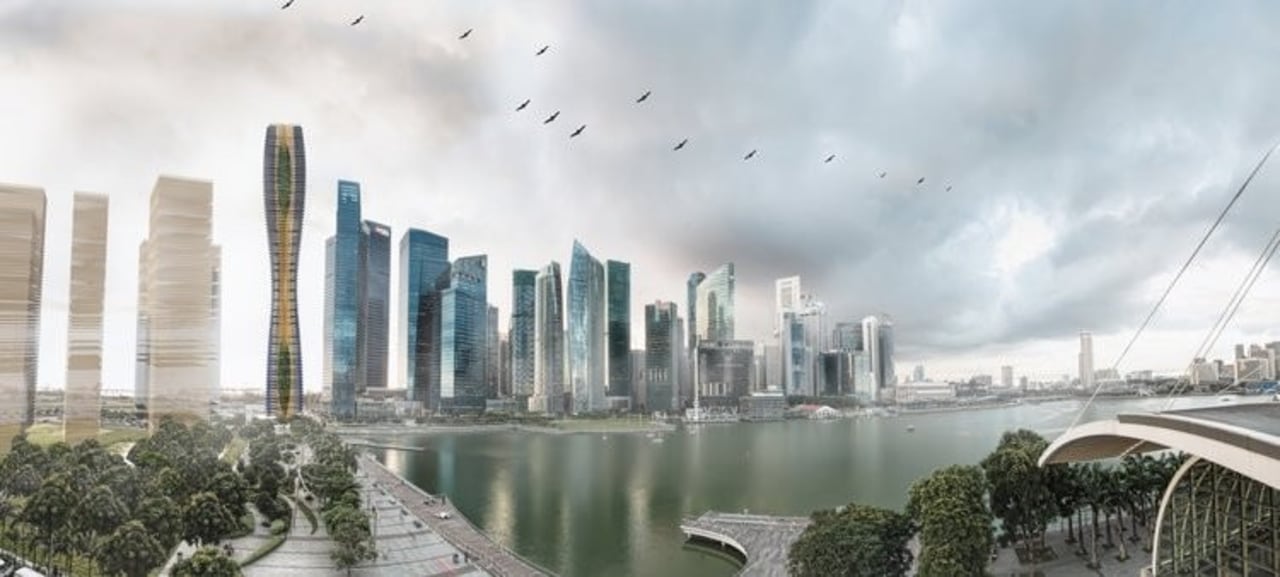Award winning firm + leading university to tackle skyscraper made entirely from timber
WEIJENBERG, alongside the Singapore University of Technology and Design (SUTD),
Architect/Designer: WEIJENBERG and Singapore University of Technology and DesignFrom the firm: Award winning firm, WEIJENBERG, together with Singapore University of Technology and Design (SUTD), are reimagining the Singapore skyline with a tower made entirely of timber (a low-carbon alternative to steel or concrete high-rise construction). Following 2016’s announcement by the Singapore Government to install 5,500 HDB blocks with solar panels by 2020, WEIJENBERG takes one step further towards a greener Singapore of the future to meet the city state’s ‘Sustainable City 2030 Agenda’.
The proposed design is a conceptual tower in the Central Business District, creating a sustainable, energy efficient building, However, it is a methodology that can be applied residentially, addressing the demand for high-rise housing across Asia.
An advantage of towers is their ability to accommodate high urban densities, maximise built-up areas with views, natural light and ventilation while creating energy savings through shared facilities, improved amenities, viability of better public transport and reduced car dependence. In newly-developing areas, building dense makes it feasible for city investment to extend transport networks and public amenities, in turn avoiding urban sprawl, creating economic opportunity and raising the standard of living for inhabitants.
An excellent sustainable alternative to concrete or steel, engineered timber requires a different structural design approach for high-rise buildings. Pushing the boundaries of wooden tower design, WEIJENBERG and SUTD researched the possibility of an 80-storey tower using digital simulation to vigorously test building structures resulting in a 4-layer nested tube system, with beams spanning to the central core. In addition to the tube structure, lateral members and chevron bracing help to stabilise the structure. Joints between members were carefully designed for load transfer with minimal material consumption taking inspiration from traditional wood working joinery. The joinery enables off-site production and is quick to assemble on site to speed up construction time.
As Asian cities expand at an unprecedented rate with the UN forecasting southeast-Asian mass urban immigration so rapid that Indonesia's urban population will reach 82% of its total population by 2050, Asian cities need speedy and sustainable high-rise construction technologies more than ever. Current ecological problems such as overcrowding, traffic congestion, heat islands and urban sprawl highlight the urgency for sustainable, and resilient urban development solutions that support mix use and diversity, while improving the environmental quality and quality of life within densifying urban environments.
Camiel Weijenberg, Founder and Director comments: “At WEIJENBERG, we aim to contribute to the sustainable architecture movement and promote this to the wider community. By integrating this prototype tower in an urban context, where each tower not only consumes less net energy as an individual unit, but optimises neighbouring buildings in its vicinity, this generates a synergy which has considered multiple aspects such as location, built environment, climate and sociocultural context. A sustainable neighbourhood must not only be environmentally sustainable, but also socially and economically viable, creating a space where people can enjoy everyday life.”Read the original press release
Story by: Trends
Home kitchen bathroom commercial design
Diving into nature
Personality plus
Classic looks, contemporary efficiency



